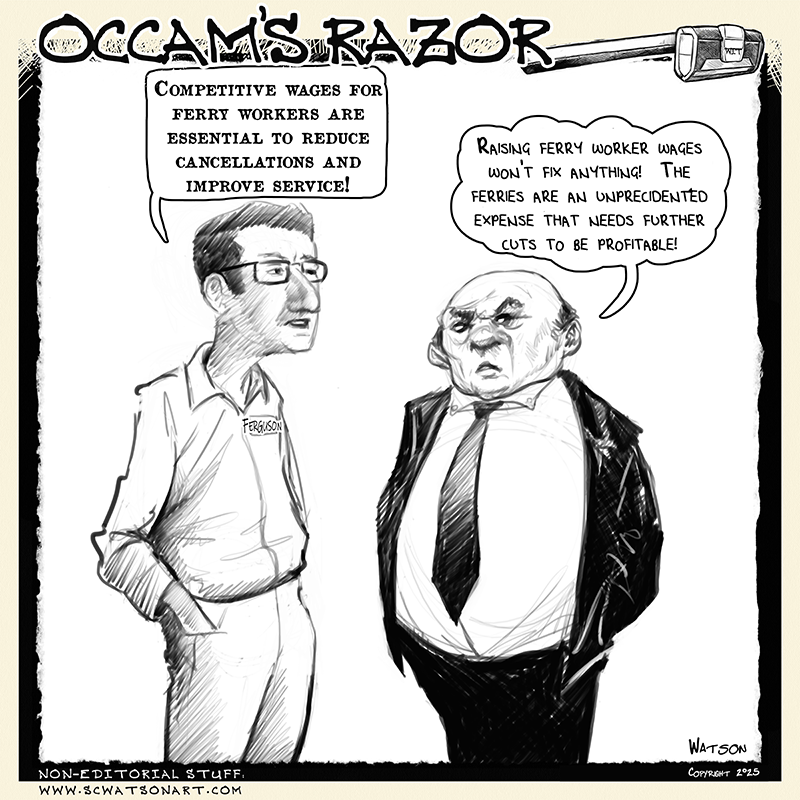— by F. Milene Henley, County Auditor —
How Are We Doing?
A recent local political cartoon pictured a person, labeled “County Budget,” stuffing money into one pocket, labeled “Reserves,” while simultaneously shuffling money from that pocket to another pocket, labeled “spending,” and pulling money out of the “spending” pocket. The cartoon made me laugh, mostly because it suggested to me that somebody had actually read the very long 2016 Budget Message. It also challenged me to work on the clarity of my writing, because it missed the mark on one key detail.
The County tried, for 2016, to put together a “status quo” budget which simply maintained existing programs while living within available revenue.
We can’t do it. We can’t pay for the services we currently provide, at the level at which we currently provide them, within current revenue projections.
Labor is about 75% of the cost of the County’s general fund. Aided by staff turnover, wages are actually growing fairly modestly, at approximately the rate of inflation. The cost of benefits, however, is growing much faster. From 2011 to 2016, retirement system costs increased 86%, projected medical insurance costs, 58%, and worker compensation costs, 56%. For 2016 alone, the cost of all benefits is projected to increase about 7.5%.
The cost of services is also projected to rise about 7.5% in 2016. “Services,” which includes a wide variety of expenses from professional services through travel and utilities, is the largest category of expense in the general fund after payroll.
Overall, expenditures in the County’s general fund are projected to increase almost 5% in 2016.
Revenues, on the other hand, are projected to remain almost flat. Property tax is the largest and most reliable source of unrestricted revenue for the County. Because of the 1% growth limitation imposed by Initiative 747, it is constrained in growth and fairly easy to project.
Sales tax, the second largest source of general fund revenue, has done quite well recently, growing at 5.25%, 8.5% and 8.5% in 2013, 2014 and 2015, respectively. Charges for goods and services have also trended upwards, though some of the recent growth has been increases in charges by general fund departments to other departments within the County.
All other revenue types have been either stagnant or highly variable. Intergovernmental revenue, which is always tough to project, is dropping substantially in 2016. Licensing and permitting revenue – primarily health and building permits – will be flat in 2016. Interest revenue and fines and forfeits remain almost unchanged since 2009.
In total, revenue to the general fund in 2016 will be essentially unchanged from 2015. With expenditures growing at 5%, the gap between revenue and “status quo” expenditures is projected at about $567,000. To make up the difference, the proposed 2016 County budget includes the use of cash-on-hand – hence the above-referenced cartoon.
Where the carton missed the mark is the source of the cash. Rather than reserves, the cash budgeted for use is coming out of “operating cash” in the general fund. Operating cash is currently well above the 10% level required by the County’s reserve policy. With the County’s current strong cash position, we can, in the short term, meet both our operational and our reserve objectives, even with consuming some cash. Long-term, however, the imbalance between revenue growth and expenditure growth remains a problem we must solve, or balancing our budget with cash-on-hand will be no laughing matter.
F. Milene Henley is the San Juan County Auditor. You can find the full text of the 2016 Budget Message at: https://sanjuanco.com/Auditor/docs/Budget_Reports/2016_Preliminary_Budget_Book.pdf.
**If you are reading theOrcasonian for free, thank your fellow islanders. If you would like to support theOrcasonian CLICK HERE to set your modestly-priced, voluntary subscription. Otherwise, no worries; we’re happy to share with you.**








Milene:
Thanks for the ‘clarity’ in your explanation.
The benefit costs not growing linearly – or if they are it is a very steep annual growth rate. At some point the growth of these costs may move toward an exponential growth rate.
Revenues are FLAT (for now), but even with a 1 – 3% growth in county revenues, I have to ponder the question:
Is it possible to ever catch up with the projected growth in benefit costs (specifically) and the total county cost structure (generally)?
And if it is possible, what are the prospective ‘REVENUE GROWTH’ areas that will make it so?
That is a question I would love to hear you respond to.
Many thanks.
Joseph Cohen